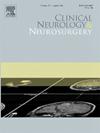Coagulopathy at admission in traumatic brain injury and its association with hematoma progression: A systematic review and meta-analysis of 2411 patients
IF 1.8
4区 医学
Q3 CLINICAL NEUROLOGY
引用次数: 0
Abstract
Progressive hemorrhagic injury (PHI) is a frequent complication of traumatic brain injury (TBI). This study aims to investigate the impact of coagulation factors (platelet [PLT], prothrombin time [PT], activated partial thromboplastin time [aPTT], international normalized ratio 1, fibrinogen [Fg], D-dimer [Dd], and fibrin [Fib]) at admission and PHI development through a comprehensive systematic review and meta-analysis based on PRISMA 2020 guideline. Databases including PubMed, Scopus, Web of Science, and Embase were searched up to March 2024. Controlled observational studies examining the relationship between coagulation tests at admission and PHI in isolated TBI cases were included. Risk of bias was assessed using the Joanna Briggs Institute (JBI) checklist, and statistical analyses were performed using Stata software, employing Hedge's g to measure effect sizes. Sixteen studies encompassing 2411 TBI patients were included. Significant associations were found between decreased PLT (g = −0.243, P = 0.007), increased aPTT (g = 0.117, P = 0.037), increased INR (g = 0.217, P = 0.0202), elevated Dd levels (g = 1.57, P = 0.0084), and decreased Fg levels (g = −0.26, P = 0.0001) with the risk of developing PHI. PT showed no significant effect on PHI risk (g = 0.19, P = 0.0372). Our results suggest that elevated INR, Dd levels, and aPTT are linked to an increased risk of PHI. Conversely, higher PLT and Fg levels appear to be associated with a reduced PHI risk. Notably, Dd demonstrated stronger predictive power for PHI.
外伤性脑损伤患者入院时凝血功能障碍及其与血肿进展的关系:2411例患者的系统回顾和荟萃分析
进行性出血性损伤(PHI)是创伤性脑损伤(TBI)的常见并发症。本研究旨在通过基于PRISMA 2020指南的综合系统综述和荟萃分析,探讨入院时凝血因子(血小板[PLT]、凝血酶原时间[PT]、活化部分凝血活酶时间[aPTT]、国际标准化比率1、纤维蛋白原[Fg]、d -二聚体[Dd]和纤维蛋白[Fib])对PHI发展的影响。检索截止到2024年3月的数据库包括PubMed、Scopus、Web of Science和Embase。纳入了检查入院时凝血试验与孤立TBI病例PHI之间关系的对照观察性研究。采用乔安娜布里格斯研究所(JBI)检查表评估偏倚风险,使用Stata软件进行统计分析,采用Hedge’s g衡量效应大小。16项研究共纳入2411例TBI患者。PLT减少之间的重要关联被发现(g = -0.243, P = 0.007),增加aPTT (g = 0.117, P = 0.037),增加印度卢比(0.0202 g = 0.217, P = ),Dd水平升高(0.0084 g = 1.57, P = ),和减少Fg水平(0.0001 g = -0.26, P = )与发展中φ的风险。PT对PHI风险无显著影响(g = 0.19, P = 0.0372)。我们的研究结果表明,INR、Dd水平和aPTT的升高与PHI风险的增加有关。相反,较高的PLT和Fg水平似乎与较低的PHI风险相关。值得注意的是,Dd对PHI的预测能力更强。
本文章由计算机程序翻译,如有差异,请以英文原文为准。
求助全文
约1分钟内获得全文
求助全文
来源期刊

Clinical Neurology and Neurosurgery
医学-临床神经学
CiteScore
3.70
自引率
5.30%
发文量
358
审稿时长
46 days
期刊介绍:
Clinical Neurology and Neurosurgery is devoted to publishing papers and reports on the clinical aspects of neurology and neurosurgery. It is an international forum for papers of high scientific standard that are of interest to Neurologists and Neurosurgeons world-wide.
 求助内容:
求助内容: 应助结果提醒方式:
应助结果提醒方式:


